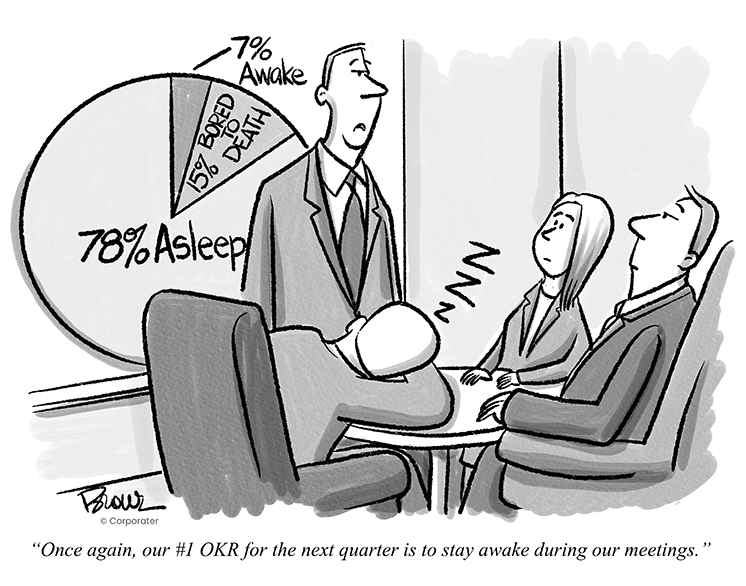
Most organizations pursuing a measurement and strategy execution system such as the Balanced Scorecard or OKR will opt for open communication of all goals, throughout the company. They’re striving for transparency, which fosters shared understanding of goals and promotes cross-functional collaboration as teams recognize opportunities for cooperation.
Transparency often begins at a quarterly town hall meeting or another gathering of multiple groups, during which each team or department outlines the goals they’ve chosen for the upcoming period. While the range of effectiveness of these meetings varies widely, many organizations struggle to maintain a productive level of dialog and discussion. By the latter part of the meeting, the session often devolves into a rapid-fire reading of goals with absolutely no questions or requests for clarifications arising from an often bored and otherwise engaged (with their phones and laptops) audience stooped in their chairs stealing glances at the clock.
Here are three ideas to assist you in harnessing the power of transparency through better engagement of your meeting participants.
- Remember the storyEvery story ever told — your favorite novel, movie, or play — adheres to a roughly similar formula. It starts with conflict, the problem faced by the protagonist compelling him or her to action. Next comes transition, the phase of the story during which our hero ventures forth into the world encountering increasingly difficult obstacles on their chosen path. Every story reaches a climactic point of action or drama during which the protagonist either achieves, or is denied, their ultimate quest. Finally, the story closes with the “new normal” state for our hero. The problem in most goal sharing meetings is that virtually all groups will simply read aloud their goals. In our schema above, that’s the climax of the story. But without the conflict and transition we, the audience, have no context for that climax. Little wonder we don’t engage — we don’t know what led the group to that choice of goals. Imagine how much more impactful a presentation would be if a group began by outlining the specific challenges they face at this moment, the conflict in their environment. Then they pivot to discuss the options they considered to overcome those challenges in the form of goals (their transition). Now we’re ready to hear the selected goals; we have the context necessary to either agree or challenge their choice. The takeaway here is this: Don’t allow your groups to simply read what is on the screen behind them. Challenge them to frame their goals in a story. It’s better for them, and much better for engaging the audience.
- Draw on the wisdom of Steven CoveyOne of our favorite (of many) principles put forth by the management guru Steven Covey is “Three-Person Teaching.” Covey rightly believed that the best way to learn anything is to teach it. We can draw on that wisdom to improve the engagement in our goal sharing meetings. Before the meeting assign dis-similar groups to conduct the initial presentation of another team’s goals. Perhaps HR will be assigned to present the engineering department’s goals and vice versa. The team who owns the goal will of course embellish the presentation with additional details, and answer any questions, but this process forces teams to learn more about other functions work, building empathy and laying the path for potential collaboration. Each period you can reshuffle the deck, building bridges between what could previously be considered unrelated functions.
- Use theme teamsIn this approach you nominate teams or individuals to provide summaries of presented goals and begin the discussion period. One option is to make three teams (this is an arbitrary number) the official observers for the first set of presentations. Make it clear that it will be incumbent on them to offer their feedback at the conclusion of the first round of goals. Of course, others may chime in as well, but at the very least you’ve guaranteed the attention of a subset of your audience. A second option is to draw randomly from the group — after a set of presentations, choose a random set of teams to offer input. This forces everyone in the room to stay present.
Measurement systems require disciplined and thorough execution along with a good bit of nurturing as you go. By following the advice above, you’ll be clearing a path and well on the way to more engaging and productive meetings, resulting in transparency across the organization.
